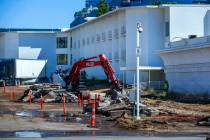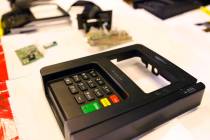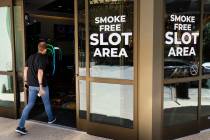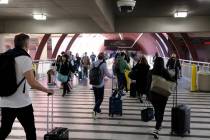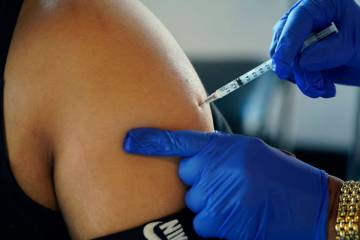Nevada paying unemployment claims faster than many states, data shows
Federal data reveals Nevada is performing better than most states in paying unemployment claims, even as residents like Mark Healy have lost patience dealing with the state’s busy phone lines, unresolved claims and ongoing payment delays.
A Review-Journal analysis of U.S. Department of Labor data shows the state’s Department of Employment, Training and Rehabilitation not only paid people faster than many states, but it improved its speed in March and April — even as the state reported the highest unemployment rate nationally amid record numbers due to the coronavirus pandemic.
Nevada saw a six-fold increase in claims in March, vastly surpassing the previous record number of claims seen during the Great Recession.
But Las Vegan Healy said Nevada’s comparative performance doesn’t mean anything to him.
“I’m going on 14 weeks without a paycheck,” he said.
DETR has not disclosed how many Nevadans like Healy are still waiting to see any money from the state. But based on the number of claims with pending issues, which the agency does report, there were at least 23,777 people who have not received money as of June 6.
How Nevada compares
Nevada’s economy virtually shut down overnight on March 15, when Gov. Steve Sisolak mandated the closure of casinos, restaurants, bars and other nonessential businesses.
Nearly two months later, Sisolak began reopening businesses, but with many companies operating at reduced capacity to follow social distancing measures, and customer demand too low to warrant bringing back workers, thousands of Nevadans are still unemployed.
Using data from the DOL, it’s impossible to discern how many people who filed for unemployment benefits for the first time in March received a payment in March, because payment numbers for that month also include people who may have first filed weeks or months before.
However, the Review-Journal analyzed the percentage of the state population who received their first unemployment paycheck in March within seven days. Data shows 87.7 percent of jobless Nevadans received their benefits within one week of filing in March, ranking it 17th when compared to other states.
“While there is still enormous amounts of work to be done, it is important to acknowledge the department’s efforts and successes as it relates to the most unprecedented unemployment situation the state and the country have ever experienced,” DETR spokeswoman Rosa Mendez said in a statement.
Any positive finding right now with Nevada — you take what you can get. I don’t have to tell you Nevada was one of the hardest hit states.
Adam Kamins, Senior regional economist at Moody’s Analytics
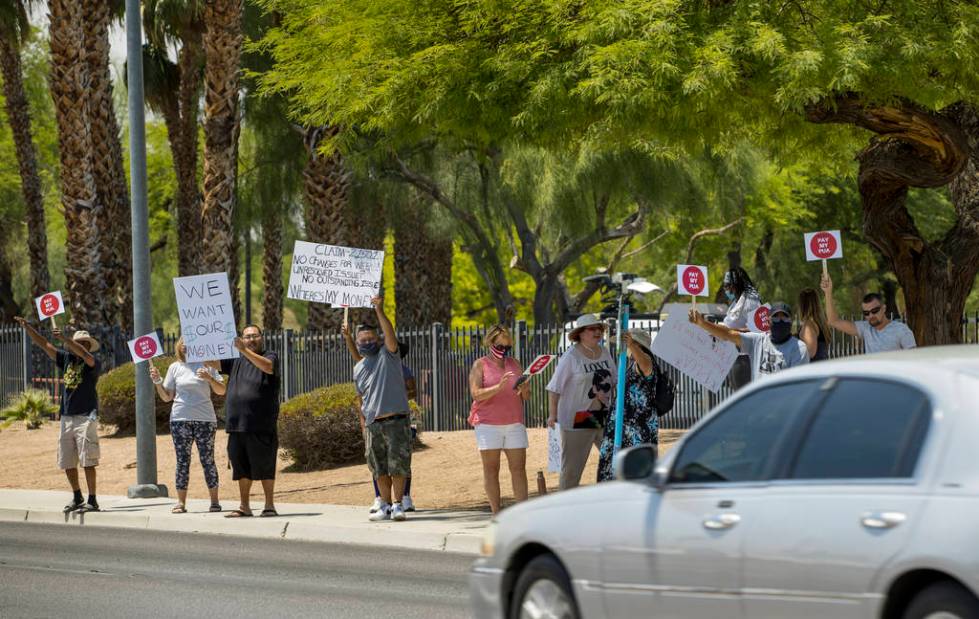
Roughly 7 percent of the state’s population requested help that month, ranking Nevada second in the country in the percentage of its population filing new claims.
“Any positive finding right now with Nevada — you take what you can get. I don’t have to tell you Nevada was one of the hardest-hit states,” said Adam Kamins, senior regional economist at Moody’s Analytics. “By the objective measures that we have, Nevada does seem to be doing a lot better than many of its counterparts.”
In April, the state paid 63.6 percent of people within seven days, ranking 18th nationally.
Before the pandemic upended daily life, data shows Nevada ranked 38th in January and 36th in February, paying only about 54 percent and almost 51 percent of the population, respectively, after the federally mandated one-week waiting period. Sisolak waived that waiting period in March for an indefinite amount of time.
How we did the unemployment claim analysis
The Review-Journal set out to determine if Nevada’s Department of Employment, Training and Rehabilitation (DETR) system was managing claims properly under the COVID-19 outbreak and subsequent economic shutdown. To determine that, we undertook an analysis of data.
The U.S. Department of Labor releases monthly data collected from all 50 states, District of Columbia, Virgin Islands and Puerto Rico, showing how many initial claims the state received, how many people received their first check and how long it took for people to get their checks. The data goes back to 1971.
Using those databases and merging them with Census population figures, the Review-Journal was able to determine what percentage of people received their first checks each month, the months with the highest claims and how many people were paid quickly.
The data did not include the number of unemployed people in each state, so percentages were derived from comparing claims paid, initial claims and state population drawn from Census data estimates.
The data did contain some faulty numbers submitted by states and DOL officials said they were trying to clarify some submissions. The data often is incomplete for weeks as the labor department waits for states to report – with some states failing to report until several weeks after the majority have already provided data.
This analysis did not include the thousands of independent contractors and the self-employed who were able to file for unemployment benefits with DETR under the Pandemic Unemployment Assistance filing system, which rolled out with technical glitches weeks after the federal program was announced.
Skyrocketing claims
The Century Foundation Senior Fellow Andrew Stettner said it’s surprising Nevada improved its ranking considering the flood of claims brought by the pandemic’s economic impact.
He said the improvement probably can be attributed to the state doing away with the one-week waiting period.
“They basically get another week (to see money) faster, but it’s still surprising,” he said. “It’s showing for the people getting paid, once they’re determined eligible, they’re getting payments quickly.”
Meghin Delaney, a communications director for Sisolak’s office, said, “Nevada has done an incredible job during unprecedented circumstances to connect eligible Nevadans to their benefits,” and added that Sisolak “understands the frustrations of Nevadans who feel the system is too slow and outdated, and recognizes there is still more work to be done.”
Southern Nevada’s economy was initially on strong footing, beginning the year with an unemployment rate of 3.8 percent in December, tying with the state’s record-low unemployment rate set in February 1999, according to DETR.
But the coronavirus pandemic sparked sweeping business shutdowns and other closures in March, spurring thousands of layoffs and furloughs.
Nevada reported more than 208,000 new applications for unemployment benefits that month, making it the largest number of claims in the state since the labor department started collecting claims data in 1971.
April’s 207,147 new claims also marked a record for Nevada.
The third-highest month for claims was December 2008, during the Great Recession, but there were only 36,414 that month — a sixth of what DETR saw in March. Meanwhile, the state’s population increased about 14 percent since that time period.
More than 528,000 new claims have been filed through the week ending June 13, and 506,893 of those claims were submitted in the past 14 weeks, according to DETR.
Last month, DETR Director Heather Korbulic told the Review-Journal the unemployment division was receiving 10,000 claims a month prior to the coronavirus pandemic but is now averaging 10,000 a day.
‘Mentally broken’
The department has had its share of issues dealing with the skyrocketing numbers of claims, and there have been several changes in leadership since March. Korbulic replaced Tiffany Tyler-Garner in May, and Korbulic announced her resignation last week “due to threats to her personal safety.” A written statement did not specify what kind of threats Korbulic received, but frustrated claimants have circulated her home address online.
She will return to her former post heading the Silver State Healthcare Exchange. A new interim director has yet to be named.
The DOL data does not track some of the main complaints that recipients have had with DETR such as long call wait times, payments for independent contracts and self-employed workers, problems with the state websites, and failures to promptly pay the $600 in extra unemployment that the federal government authorized. It also does not track the failure to pay or the numbers actively receiving benefits in a way that allows an analysis of what percentage of active recipients are paid in what time frame.
Brookings Institution Senior Fellow Gary Burtless said roughly 31 million people in the United States were collecting some form of unemployment benefits by May.
“We’ve never remotely approached a number like that in our whole history,” he said. “You can say there were a lot of mistakes. We didn’t do a great job. But you got to be a little bit forgiving … bearing in mind all these state agencies have faced exactly the same problem that the rest of us have: Their workers are fearful (asking), ‘Am I going to get sick?’ ”
Healy applied for benefits March 27 after being laid off from his job as a cook at The Strat.
He’s called DETR hundreds of times each day and says he’s “pretty lucky” compared with other filers, since he was able to speak with a DETR representative.
But he said he’s been told conflicting information as to why he could not claim his wages from The Strat, where he started working in December.
The only income he’s received in nearly four months was the $1,200 federal stimulus check.
“I’m pinned up against the wall,” Healy said. “I can’t pay my bills. My dog needs his medication, and I can’t get them. I never thought I could ever be mentally broken down like this.”
Still waiting
The data reflects a state outperforming other states in processing jobless claims during a time of economic contraction, but there are still thousands who have yet to receive their benefits, like Healy and former Las Vegas resident Damon Taylor.
Taylor worked for a transportation company in Henderson but was laid off in March.
He filed for unemployment March 20 but has not received a check or spoken with a DETR representative to have his interstate claim adjudicated, adding that he spent half of 2019 working in Nebraska.
Taylor has sent emails, faxes and calls the unemployment office every day only to hear a recording saying the office has exceeded its call volume and to try again the next day.
He exhausted his savings and moved to Phoenix in April for a temporary job, adding that he could no longer afford to live in Las Vegas without an income.
“You can claim you’re doing better than anybody else, but for people like me that haven’t been able to speak to anybody or even have somebody look at (my claim), I don’t think they’re doing that great,” Taylor said.
The Review-Journal is continuing to examine DETR’s response to the unemployment crisis. If you’d like to share your experience applying for unemployment benefits, email us at DETR@reviewjournal.com.
Contact Subrina Hudson at shudson@reviewjournal.com or 702-383-0340. Follow @SubrinaH on Twitter. Contact Arthur Kane at akane@reviewjournal.com. Follow @ArthurMKane on Twitter. Kane is a member of the Review-Journal’s investigative team, focusing on reporting that holds leaders and agencies accountable and exposes wrongdoing.







